“Naked” Is Dutch for “Nude”
The Early History of the Dutch Treaters and Their Cartoonists
NO HISTORY OF THE DUTCH TREAT CLUB can proceed very far without confronting the issue of nakedness. Or, if you prefer, nudity. “Racy” is a quaint term for the phenomenon being rehearsed herein. “Risque” is even quainter: it has its origin in a foreign language, French: “from the past participle of risquer, to risk,” the dictionary tells us. Something “risque” risks offending the more upright (not to say “uptight”) portions of the populace. Likewise “racy” which describes something a little “fast,” in the sense of loose morals; “risque” suggests “indelicacy” or “impropriety.”
Neither “racey” nor “risque” are terms much bandied about in the opening decades of the 21st century, an age of tweets and twitters and sexting in which discussion of sexual matters is too commonplace to be deemed “indelicate”—or even out of the ordinary. But in the 1930s when many of the pictures we’re posting hereabouts were first published, we were more circumspect.
We were no more saintly or decorous in our behavior, particularly in private: in public, we merely masked our sexual proclivities with feigned modesty. And that’s what made those times quaint. Pretense was all. Social delicacy and moral propriety were the watchwords of polite society in that distant time.
The pictures we’re about to contemplate, drawn mostly by cartoonists, are therefore revolutionary statements. There is hardly anything more indelicate than a picture of a naked woman, and this report includes pictures of naked women. Not nudes: “nude” is French for “aristic nakedness”—nakedness that has about it an element of the artificial, the contrived, the refined. Not quite erotic but close. “Erotic,” as we have come to know, is French for “Playmate of the Month” whose pose and expression denote seduction, a candid invitation to foreplay and aftplay.
No, the pictures at hand are of naked women. Their poses are straightforward, inelegant, unprovocative. Even restrained. Simply the naked female of the species.
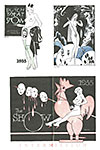 |
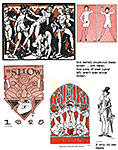 |
And when these pictures were drawn or painted, naked was inflammatory enough. In those more repressive times of yore, mere nakedness was arousing. Men had, except in burlesque houses, never seen naked women other than their wives (and even them, not very much).
The reason that naked women were verboten in those distant, dismal times is that beholding naked women aroused lust in men. (Men are the only sex that cannot fake lust. Women can fake it, but men can’t. A man in the grip of lust cannot hide it—particularly if naked.) And our Puritan forefathers objected to lust. Lust leads inevitably to sexual activity, coitus and the whole litany of the carnal catalogue. And sex, to all of those Puritans, was not to be tolerated. Sex destroyed orderliness. It was to be triumphantly eschewed. Except in the dark. And usually in bed, where sheets and coverlets and general dishabille on all sides could obscure the view.
But the makers of the pictures around here were, as I said, revolutionaries. They were all members of the Dutch Treat Club, an organization perpetuated in defiance of custom, orderliness, delicacy, and propriety.
The Dutch Treat Club began innocently enough. James Montgomery Flagg, who was president of the Club for years, says it started in 1911; other sources say 1905. Perhaps both. But it was a Tuesday in each iteration.
On Tuesdays in those days, writers and artists who lived in Manhattan or in its far-flung suburbs convened at the office of the old Life humor magazine at 19 West 31st Street to submit essays, poems, or drawings for the next issues of the publication.
Waiting
in a waiting room for an audience with either James A. Mitchell, the
founder and art editor, or Thomas L. Masson, the literary editor, the
supplicants got to know one another and to enjoy each other’s company. Since
they were all in the City for the day, it was natural that they would want to
prolong the convivialities of Life’s anteroom, and so they fell into the
habit of lunching together, first at the ornately facaded Hotel St. Denis, a
fashionable hostelry twenty blocks south at 11th and Broadway. (It
was converted to a bland office building in the 1920s and then died; the old Life office building is still operating, however—with Life’s mascot, a
gold-leaf cupid, hovering over the entrance—as the Herald Square Hotel, its
sleeping rooms the erstwhile quarters and studios for Life’s bachelor
staffers.) 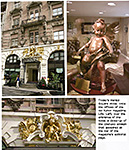
The Life contributors began bringing friends and others of a creative bent who had no particular connection to the magazine, and the numbers grew until one Tuesday some wag in attendance gave the group its name, appropriated from the custom of everybody paying for his own lunch.
Flagg says the Club was Masson’s idea; others say Robert Sterling Yard, a reporter at the New York Sun, was co-founder. Masson served as the first president; Flagg, as its second. Most accounts say the founding group consisted of eleven personages—four writers, four illustrators, two editors, and a publisher. The four artists doubtless illustrated cartoons for Life and were, ipso facto, cartoonists; and vice versa.
Oddly, Flagg maintained all his life that cartoonists weren’t artists. “I am fond of cartoonists,” he confessed in his memoir Roses and Buckshot, “—they are a very intelligent race of men except that they have a curious complex: they all think they can draw. They are quite sincere in this delusion, even to the point of calling their offices ‘studios.’”
Flagg’s opinion was odd because he started as a cartoonist: he began his distinguished career as an illustrator by drawing cartoons for Life and other humor magazines. He even drew a one-page comic strip for the old humor magazine Judge—Nervy Nat. In later years, he determinedly disowned these early efforts.
 |
 |
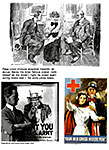 |
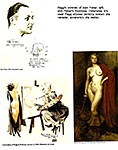 |
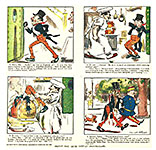 |
|
“There are really only about a half dozen cartoonists in the world who can draw,” Flagg said, “and David Low is at least four or five of them.” Flagg stoutly maintained that there were only five great caricaturists in the world: Low, W. Cotton, Floyd Davis, Al Frueh, and Conrado Massaguer.
In one of Judge’s collections, contributors are pictured, and the photographs are accompanied by short verses. Flagg’s is as follows:
F is for flourishing Flagg,
A versatile artist and wag.
Familiarly Jim,
His ardor and vim
And talents seem never to lag.
“Wag” may denote a man who expresses edgy (not to say contrariwise) opinions.
Flagg didn’t like clubs either, it seems: “One of the most pathetic impulses of Americans is their urge to form clubs. I think it’s a form of infantilism springing from an inferiority complex—a fear of loneliness and a desire to expand the little ego. So they get together and they they think, ‘Gosh, we’re wonderful, grand guys all ... but we’re only us ... let’s get some more members.’”
Men’s clubs started in London in the mid-1800s, taking over the role of 18th century coffee houses as gathering places for conversation and fellowship. They reached their peak of influence in the late 19th century, by which time they were infesting big cities in the U.S.
One of the oldest in this country is the New York Yacht Club, formed in 1844. Many American clubs are affiliated with university alumni groups; the Yale Club of New York, started in 1897, is the largest private club in the world. Other clubs include Salmagundy Sketch Club for artists (1871); Quill Club, journalists (1888); Players Club, actors and related arts (literary, painting, etc. in 1888); Lotos Club, promoting journalism and the arts, literary among them (1870); Lambs Club, literary and the arts again (1874); Grolier Club; promoting literature and publication of books (1884). The Society of Illustrators, in which Flagg was a major figure, was started in 1901.
Flagg, despite his professed annoyance at clubs and clubmen, was active in several—Players, Lotos, and Lambs among them. Given his capacity for being outraged, he would probably spiral into high decibel dudgeon if he knew that when the Lambs began admitting women to membership, the club had added clothing to his paintings of nudes that hang on dining room walls.
The Dutch Treat Club attracted as members people engaged in creative endeavors in entertainment and communication. “The Club is a picked body of three hundred men who are active agents in the production and dissemination of literature, art, music and drama in New York” said John O’Hara Cosgrave in 1943 (chairman, since 1924, of the Board of Governors). “They are editors of magazines, newspapers and books; they are also writers and illustrators, composers, singers, playwrights, actors and entrepreneurs.”
Every week, its lunches featured a noted entertainer or prominent person as a speaker. By the 1940s when Flagg was writing his memoirs, membership had grown, he said, “to appalling size. It is not a club. It is a battalion.”
“In the decades before World War II,” wrote Dan Nadel (in Print magazine, January 2001), “there was no greater concentration of luminaries—leading literary and artistic lights in New York—no audience more influential than that of the Dutch Treat Club.”
The weekly lunches were inevitably boisterous (from the French “boys will be boys”), and the roistering by so many engaged in the entertainment arts inevitably led to indulging an impulse to put on a show of their own—for just the members.
The first of these may have been an operetta written by John Reed, a famously notorious American Socialist whose book about witnessing the 1917 Bolshevik revolution in Russia, Ten Days That Shook the World, got its author an honored gravesite in the wall of the Kremlin close to Lenin’s tomb. Flagg thinks Reed’s Dutch Treat opus was committed just after Reed graduated from Harvard in 1910, but Reed spent his post-graduate year touring Europe, and it may have been as late as 1913 that he wrote the operetta that Flagg calls the first for the Dutch Treaters. There may have been non-operatic shows before Reed’s.
The shows were staged annually, and Flagg wrote many of them, “all lampooning the artistic professions and the magazines” with satirical skits and ribald songs. Flagg’s motto: “We strive to annoy!”
In the same antic iconoclastic spirit, the Club began in 1920 to produce a yearbook, from which have been culled the pictures we’ll eventually get to.
“There was no yearbook more extravagant than the Dutch Treat Club’s yearbook,” Nadel attested. “Irreverent and bawdy, the books are printed versions of the Club’s leisure activities, participated in by its eminent members ... fascinating visual artifacts of a bygone legendary time.”
The term “yearbook” implies a large, encyclopedic volume the size of a small coffee table, but the Club’s yearbooks were tidy tomes of about 100 5x8-inch pages. Small bore but elegantly produced: most pages carried a second color in addition to foundation black, and the second colored varied from page to page. One year, some drawings of fashionably attired women were reproduced in two colors—orange and green; and when a sheet of orange-color cellophane (supplied with the book) was laid over the drawing, the orange disappeared and the green remained to display the woman naked.
The books were produced to be distributed at the annual show and included, in addition to drawings, the scripts and lyrics of the skits and songs, humorous poems, satirical essays, and a complete membership directory.
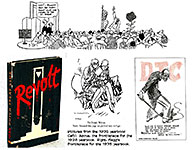 |
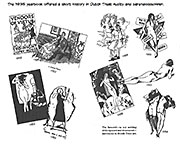 |
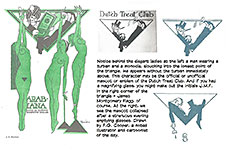 |
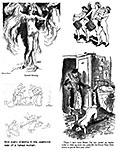 |
The books were furnished with a “report” by an officer of the Club; in the 1930s, the officer was the president, Clarence Buddington Kelland, who once described himself as “the best second-rate writer in American.” He was a fiction writer of more than 200 short stories and sixty novels, including a series about Scattergood Baines and, for young readers, Mark Tidd. He also wrote a magazine serial, “Opera Hat,” that was the basis for the film “Mr. Deeds Goes to Town” starring Gary Cooper.
Kelland took seriously his self-imposed duty to produce an “annual message” for the membership, but his mocking message, tongue in cheek, often dismantled the Club, calling for resignations and abolitions in every direction at once.
One year, he outlined a series of dilemmas and provocations, from which I’ve mined the following collage by way of demonstrating the intensity of Kelland’s dedication while also setting the mood for the rest of this opus:
“A major problem is that of baritones. There is over production in this field,” Kelland began— and then continued: “The market is glutted. The ear is deafened by the harsh, discordant note of this type of voice by day and by night. I recommend that a selected few be kept for breeding purposes and the remainder be converted into tenors. Otherwise, baritones should be abolished. Composers and pianists should be abolished. This would clean up the Show so that nothing but pornographic words would remain.
“Tuesday luncheons should be abolished,” Kelland went on.
“The Hotel McAlpin (site of the Tuesday luncheons as they moved uptown from the St. Denis to the Brevoort, thence to Keen’s Chop House [Flagg’s favorite] and the Martinique and onward to the McAlpin) should be abolished.
“The Book should be abolished. This would serve no good purpose except to further the good work of Abolition.
“Another and perhaps more trying problem is membership,” Kelland continued, on a roll now, “—unfortunately, our members must be selected from practitioners of the so-called Creative Arts. This renders it utterly impossible to do anything. I recommend the admission of more gate crashers in order to maintain a certain minute semblance of reason and respectability at our meetings. And more and better resignations should be the watchword.
“During the past year too few things have been abolished. There has been too much proletariat, too much Board of Governors, too much Cosgrave, and much, much too much Kelland. These irritations should be abolished and the Club permitted to emerge triumphantly into a chaos resembling the Government of the United States.
“If any member has a complaint about anything he will be listened to courteously and appointed a committee of one to remedy whatever he finds wrong.
“Lastly, the existence of the Dutch Treat Club itself. This, of course, is the most serious defect of this organization and renders any betterment in its condition practically impossible. I make no recommendation but appoint April First as a day of fasting and prayer.”
In 1934, Kelland thought better of the last recommendation:
“The Dutch Treat Club is, after all, pretty much a state of mind. I earnestly suggest that everything shall be let to go on in the future as it has gone on in the past and that we chase after no strange gods or New Deals. Let the Dutch Treat Club stand permanent, unchangeable as a proof to a wavering world that nothing succeeds like disorganization, inefficiency and a blessed talent for letting things rip.”
Privately printed for the Club’s members—all of whom for several decades were men until the walls of the masculine redoubt were breached by the feminist fervor of later years—the yearbooks are typical unabashed fare for “dirty old men.”
The
pictures of naked women in full frontal glory, as I’ve said, were unusual for
the day—candid, unblushing, pubic hair displayed with innocent abandon (years
before Playboy made pubic hair a cause celebre; but then the
Dutch Treat yearbook was privately printed for an exclusive readership for
which nothing should be left to imagination, including pubic hair). 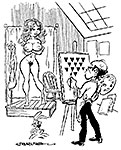
Today, pictures of naked women are no longer quaint. Nor are they even racy or risque. They are commonplace. And those who draw them are no longer revolutionaries. But they are still in a minority, a minority persecuted for their preoccupation. (Try announcing that you’re a “girlie cartoonist” at your next soiree and see the crowd thin.)
The Dutch Treat Club’s ribald yearbook may well have set the pace and the example for artists and cartoonists drawing naked women. It took a while for some of us to catch up: despite the furtive persistence of Tijuana Bibles in the thirties and forties, it was the age of Playboy cartoons dawning in the fifties that prolonged and embellished the Dutch Treat example, supplanting the exemplar with a beau ideal that endured until Internet porn rudely displaced it all, turning quaint into obsolete. But our admiration of and infatuation with the form femme endures, as you might be able to tell from the nearby cluster of illustrations we’ve culled from Dutch Treat Club yearbooks of yore.
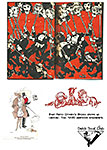 |
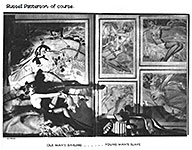 |
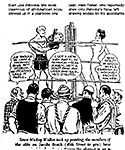 |
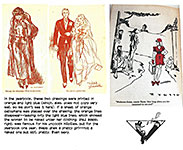 |
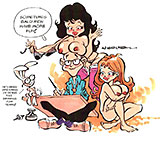 |
P.S. To the Joe Palooka illustration with him at the easel, painting, presumably because someone named Mickey Walker had taken up painting, we can add the following (courtesy St. Wikipedia)—:
Edward Patrick "Mickey" Walker (July 13, 1903 [some sources indicate 1901] – April 28, 1981) was an American professional boxer who held both the World Welterweight and World Middleweight Championships at different points in his career. Born in Elizabeth, New Jersey, he was also an avid golfer and would later be recognized as a renowned artist. Walker is widely considered one of the greatest fighters ever, with ESPN ranking him 17th on their list of the 50 Greatest Boxers of All-Time.
Someone worthy of Palooka’s imitating, in other words.
